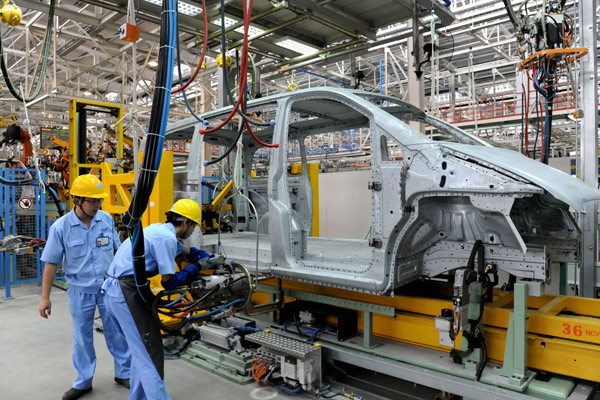No need to be pessimistic about economy
By Yu Yongding (China Daily) Updated: 2016-03-16 07:31
 |
|
An assembly line of a Daimler AG venture in Minhou, Fujian province. Investment from Germany jumped 59 percent year-on-year to $410 million in the January-February period, 2015. [Yang Enuo/China Daily] |
After 30 years of breakneck growth, the Chinese economy has entered a new normal. While accepting the fact that China's potential growth rate has slowed significantly, it is worth emphasizing that 6.5 percent is still a high growth rate. If such a rate is maintained, China will achieve its objective, set in 2010, of doubling per capita income by the end of 2020.
Over the past 30 years, one of the most important features of China's growth has been its dependence on investment, especially real estate investment. The growth rate of investment has been consistently higher than that of GDP. China has three main areas of investment: real estate, infrastructure and manufacturing. Real estate accounts for one-fourth of the total investment, and for a long period it has been the most profitable of the three.
At the end of 2015, the total floor area of unsold houses in China was more than 700 million square meters, while the average annual floor area of the houses sold in normal times was 1.3 billion sq m.
But faced with a double-digit growth in inventory, real estate developers have greatly reduced their investment. In fact, the growth rate of real estate investment has dropped to almost zero, and 2016 is very likely to see real estate investment growth entering negative territory. Considering the large share of realty development in GDP and the links between real estate and other sectors such as steel, cement, plate glass, aluminum, coal and other construction materials, one can see how large the impact the fall in real estate investment will have on overall economic growth.
Ideally, the government should encourage more household consumption to offset the fall in real estate investment, but that is easier said than done. Household consumption is largely stimulated from within, and it is unlikely to increase at a very fast pace while the economic growth rate is at its lowest in a decade.
No doubt the fundamental cause of the slowdown is structural. Apart from the diminishing returns on scale, the misallocation of resources, manifested in the investment fever in real estate development, is the main contributor to China's falling potential growth rate.
- IMF hails China economy on right way 'from quantity to quality'
- China economy enters 'new normal' eyeing 7% growth rate: G20
- Policies show focus on stable economy
- Overseas views: Offering a 'good recipe' for Hong Kong's economy
- Slower economy 'won't deter anti-pollution efforts'
- No hard landing for China's economy: CPPCC National Committee member
- China's GDP data consistent with overall strength in the economy: US experts
- China's economy likely to grow around 7% in 2016: economist
- Chinese economy 'remains healthy'

I’ve lived in China for quite a considerable time including my graduate school years, travelled and worked in a few cities and still choose my destination taking into consideration the density of smog or PM2.5 particulate matter in the region.











